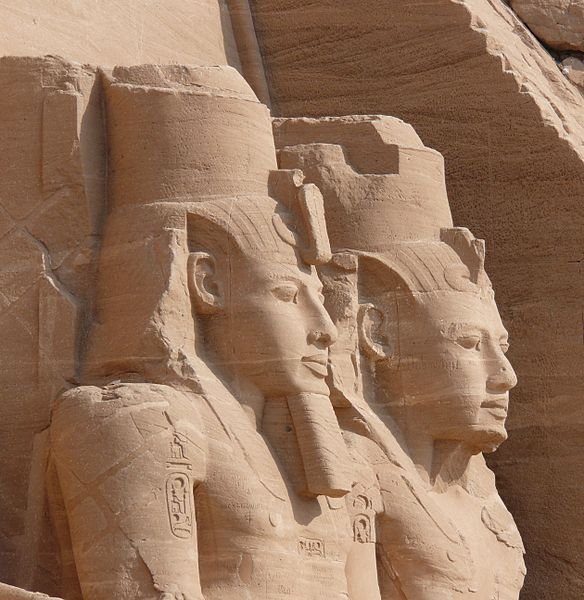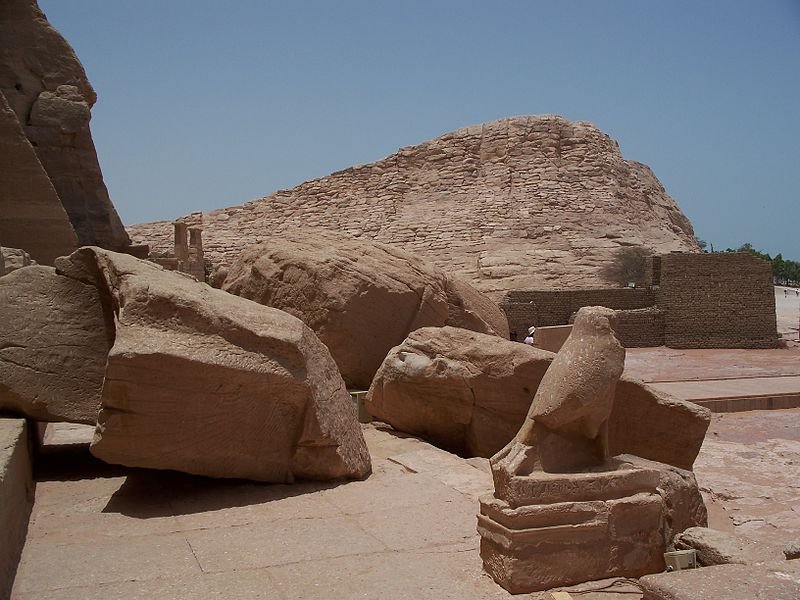 Abu Simbel Temple at night
Abu Simbel Temple at nightSource: https://commons.wikimedia.org/wiki/File:Abu_Simbel_02.jpg
Author: Angel Aroca Escomez

Abu Simbel Temple is one of the most famous ancient Egyptian temples in the world. It is one of the components of the Nubian Monuments from Abu Simbel to Philae, which was inscribed as a World Heritage Site in 1979, during the 3rd session of the World Heritage Committee meeting in Cairo and Luxor between the 22nd to the 26th of October, 1979.
The Abu Simble Temple comprises two gargantuan temples carved into the rock surface of the cliff. They are located on the banks of Lake Nasser, about 290 km from Aswan. It was built by the Pharoah Ramesses II around 1244 BC, and was used until 1224 BC. Pharoah Ramesses II built two temples, one to himself and another to his queen Nefertari, purportedly to commemorate his victory against the Hittites in the Battle of Kadesh. Called the "Temple of Ramses, beloved by Amun", the temples are among six rock temples built in Nubia. The location of Abu Simbel as chosen by Ramesses was at the southern gateway into Egypt and serves as a billboard to intimidate his Nubian neighbours and to advertise his might.
 Great Temple of Abu Simbel
Great Temple of Abu SimbelSource: https://commons.wikimedia.org/wiki/File:Abu_Simbel_Egypt_2.jpg
Author: Karelj

After Abu Simbel had fallen into disuse, sand began to engulf it. By 600 BC, the sand had buried Abu Simbel up to the knees of the gigantic statues. Eventually the entire temple was buried in sand. It was only rediscovered in 1813, when Swiss explorer Johann Ludwig Burckhardt came upon the top frieze of the main temple. The discovery was related to Italian explorer Giovanni Belzoni, who visited the site but couldn't dig the temple out of the sand. He returned in 1817 and this time managed to enter the temple. He plundered it for all the valuables that he could carry. At that time, the temple was without a name. Belzoni is said to have named it after Abu Simbel, the young Egyptian guide who took him to it.
In 1954, the Egyptian government began planning a new dam at Aswan. This was intended to relieve the load from an existing dam built by the British in 1889, and increased in height in 1907 and 1929. By 1946, the first dam was already in danger of overflowing. Rather than trying to raise its height again, a decision was made to build another dam 6km upriver.
 Chamber inside the Great Temple of Abu Simbel
Chamber inside the Great Temple of Abu SimbelSource: https://commons.wikimedia.org/wiki/File:Abu_Simbel_by_Henrique_Matos_01.JPG
Author: Henrique Matos

The construction of this new dam will increase the level of Lake Nasser, submerging many of Egypt's ancient monuments. A total of 24 major monuments were threatened by the rising water, the most important of which are the temples of Abu Simbel, necessitating a move to higher ground.
The project to relocate Abu Simbel drew participation of experts from many countries. An international donation campaign in 1959 kick-started the project. The actual work began in 1964. Over a period of four years, the temples were cut into massive blocks weighing an average of 20 tons. These were numbered and reassembled in a new location 65 meters higher than the original site, and 200 meters from the new water's edge. A hollow artificial rock mountain was constructed to showcase the monuments.
 Abu Simbel scale model showing how the original temple was relocated
Abu Simbel scale model showing how the original temple was relocatedSource: https://commons.wikimedia.org/wiki/File:Abu_Simbel_relocation_by_Zureks.jpg
Author: Zureks

Today Abu Simbel is a World Heritage Site. In fact, it was through the Abu Simbel project that the idea to safeguard the heritage sites of the world was mooted, and through this, the World Heritage Site listing was born.
The two temples at Abu Simbel are called the Greater Temple and the Lesser Temple. The Greater Temple was dedicated to the ancient Egyptian gods Amun Ra, Ra Harakhti and Ptah, and the deified Ramesses himself. It consists of four colossal statues in seated position each towering 20 metres in height. All of them depict Pharoah Ramesses II.
 Colossi of Abu Simbel
Colossi of Abu SimbelSource: https://commons.wikimedia.org/wiki/File:Abu_Simbel_011.jpg
Author: Ad Meskens

The statues were carved out of the rock where they were located. Members of the royal family are also sculptured below Ramesses. Standing no higher than the Pharoah's knees include Nefertari, queen mother Mut-Tuy, sons Amun-her-khepeshef and Ramesses, and daughters Bintanath, Baketmut, Nefertari, Meritamen, Nebettawy and Isetnofret.
Going through the doorway between the colossal statues, one enters the hypostyle hall, an elongated chamber 18 metres long and 16.7 metres wide. This hall is supported by pillars that depict the deified Ramesses linked to the god Osiris. At the end of the hypostyle hall is a second pillared chamber. From here a vestibule leads to the sanctuary. Seated within the sanctuary are four seated figures, namely Ra Harakhti, the deified Ramesses, Amun Ra and Ptah.
 Little Temple of Abu Simbel
Little Temple of Abu SimbelSource: https://commons.wikimedia.org/wiki/File:Abu_Simbel_01.jpg
Author: Angel Aroca Escomez

The Greater Temple is constructed in such a way that every year, on 20 October and 20 February, the ray of the sun would penetrate the sanctuary and illuminate three of the four seated figures; Ptah, the god of the underworld, remains permanently in darkness. The two dates are believed to commemorate the pharoah's birthday and coronation, or perhaps some other great even, such as the thirtieth jubilee of his reign. When archaeologists moved the temple, they tried to re-create the event. However, their calculations must have been out by a bit, for the rays now enters the sanctuary a day later.
One hundred meters away from the Greater Temple is the Lesser Temple, dedicated to Ramesses II's chief queen Nefertiti and the goddess Hathor. The façade, also carved from the rocks, show two groups of 10-meter tall colossi. Here, the king and queen are shown of equal size. This is very unusual, because traditionally the queen is never shown any taller than the pharoah's knees. The Lesser Temple is a rare example where both king and queen are depicted in equal size, and is also the only example of a temple dedicated to the king's consort.
 Abu Simbel, as seen from the banks of Lake Nasser
Abu Simbel, as seen from the banks of Lake NasserSource: https://commons.wikimedia.org/wiki/File:Abu_Simbel,_Nefertari_Temple,_Lake_Nasser,_Egypt,_Oct_2004.jpg
Author: Przemyslaw "Blueshade" Idzkiewicz

Getting there
Abu Simbel can be reached by flight from Cairo. At time of writing (Dec 2007), Egyptian Air flies four times a day. Another possible way to reach Abu Simbel is by boat through Lake Nasser. Due to security concerns, Abu Simbel is presently not accessible by car to foreigners. Anyone wishing to visit Abu Simbel by road must join a tour convoy. These convoys are escorted by police. Check with the Egyptian tourist office before making plans. There are usually at least one convoy per day. The trip takes 3 hours each way. Bring sunblock and water, as the journey is very hot. It is also advisable to travel on air-conditioned buses.What to see and do
You should visit both the Greater Temple and the Lesser Temple. Stand at the foot of the giant statues of Ramesses II to be awed by their size. Look for "Kilroy was here" grafitti on the lower legs of one of the 4 giant statues. Go inside the temple to appreciate that it is really built with an artificial rock mountain behind it. Colapsed colossus of Ramesses II
Colapsed colossus of Ramesses IISource: https://commons.wikimedia.org/wiki/File:Collapsed_Colossus.jpg
Author: Than217

World Heritage Site Inscription Details
Location: N 22 20 11.004 E 31 37 33.996 in the Governorate of Aswan, EgyptInscription Year: 1979
Type of Site: Cultural
Inscription Criteria: I, III, VI
Visiting Abu Simbel Temple
Abu Simbel can be reached by flight from Cairo. At time of writing (Dec 2007), Egyptian Air flies four times a day. Another possible way to reach Abu Simbel is by boat through Lake Nasser. Due to security concerns, Abu Simbel is presently not accessible by car to foreigners. Anyone wishing to visit Abu Simbel by road must join a tour convoy. These convoys are escorted by police. Check with the Egyptian tourist office before making plans. There are usually at least one convoy per day. The trip takes 3 hours each way. Bring sunblock and water, as the journey is very hot. It is also advisable to travel on air-conditioned buses.What to see and do
You should visit both the Greater Temple and the Lesser Temple. Stand at the foot of the giant statues of Ramesses II to be awed by their size. Look for "Kilroy was here" grafitti on the lower legs of one of the 4 giant statues. Go inside the temple to appreciate that it is really built with an artificial rock mountain behind it. Latest updates on Penang Travel Tips
Latest updates on Penang Travel Tips

Copyright © 2003-2025 Timothy Tye. All Rights Reserved.

 Go Back
Go Back